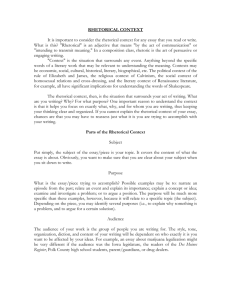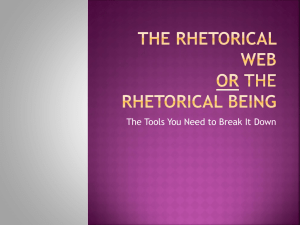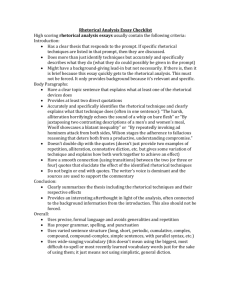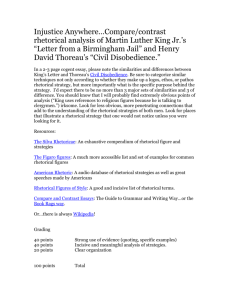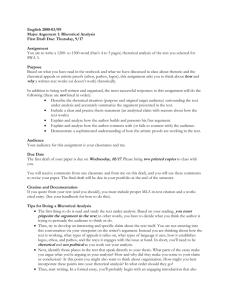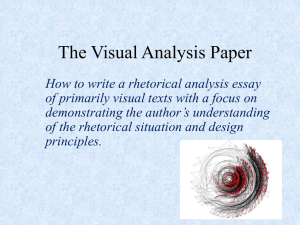Writing a Visual Analysis
advertisement
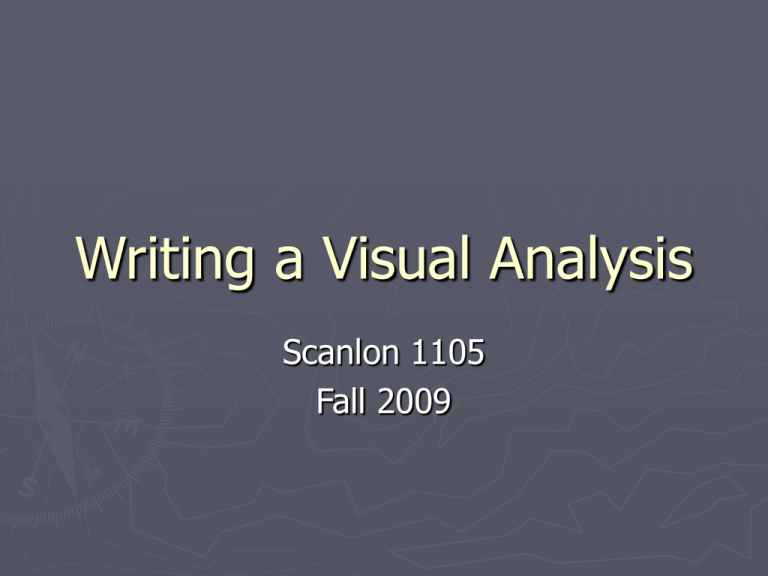
Writing a Visual Analysis Scanlon 1105 Fall 2009 Fighting Stereotypes ► Where did you find it? (print, web) ► How difficult was it to find? ► What stereotype is it fighting against? ► Where is this stereotype usually found? (magazine ads, television and film, etc.) ► Is it using that same medium in its fight? (For example, if it’s fighting the music video, is it using magazine articles, websites, etc.?) Writing a Description of the Image: ► Pretend like your audience has not seen it: Identify what is happening in the ad. What might a viewer notice first? How do the eyes “travel” across the image? ► Get detailed: What is included in this image? What is excluded? Where do elements fall on the space? Is there an implied relationship between elements? Let’s get Rhetorical: ► In what ways does your ad attempt to gain the attention of its audience? ► Which appeal is it making use of, and how? Ethos – credibility by name or brand Logos – reason/logic Pathos – emotions ► What is the audience for this ad? How do you know? Let’s Get Rhetorical ► What kinds of knowledge or experience does the ad assume its audience possesses? ► What associations might the audience make with the images in your ad? How and why are these associations important? How do they connect with the product? How might these associations motivate viewers to purchase the product? Let’s Get Rhetorical ► What kind of lifestyle do you think your advertising tries to promote? ► What kind of values? ► What the implied values? The explicit messages? Let’s Get Rhetorical ► What can you deduce about American culture in general by looking at this ad? ► What is the overall effect of the ad? Does it disorient? Surprise? Confuse? Arouse? Startle? Mesmerize? Eroticize? Valorize? Aggrandize? Glorify? Constructing a Thesis ► Let’s come up with five possible thesis statements about the VW ad: 1. European consumers value material things. ----- 2. 3. 4. 5. Now try analyzing this image: Analysis vs. Reflection ► Analysis: ► Reflection: ► Formal ► Informal ► For ► For your audience ► Remove your own voice ► Critical ► Showing your rhetorical work ► Rhetorical (making sense of the “who, what, when, where, why, and how” of an argument for your readers) you ► Personal ► Storytelling ► Explaining yourself directly to the reader ► Reflective (making sense of an event for your own personal reasons) Journal #5: A Visual Essay ►7 images to tell the story of your life + short reflection (Reflection is for you/I will not collect it) ► Place one on each slide of a PowerPoint (backgrounds and music may be added) ► You are encouraged to use any images you feel tell your story (photographs, altered or “rewritten” photographs, images from media outlets, or pictures of cultural artifacts like a computer or phone, etc.) ► Email me your PowerPoint by 9:00 p.m. on Sunday, September 27. mscanlon@vt.edu Journal #5: A Visual Essay ► Some ideas for the reflection: Why did you choose these images? Why are they important to you? What memories or thoughts does the photo trigger? How might others read these photos? What details from these photographs are especially important to your visual essay? Is there a common thread running through all of these images? (The idea of love, for example)



